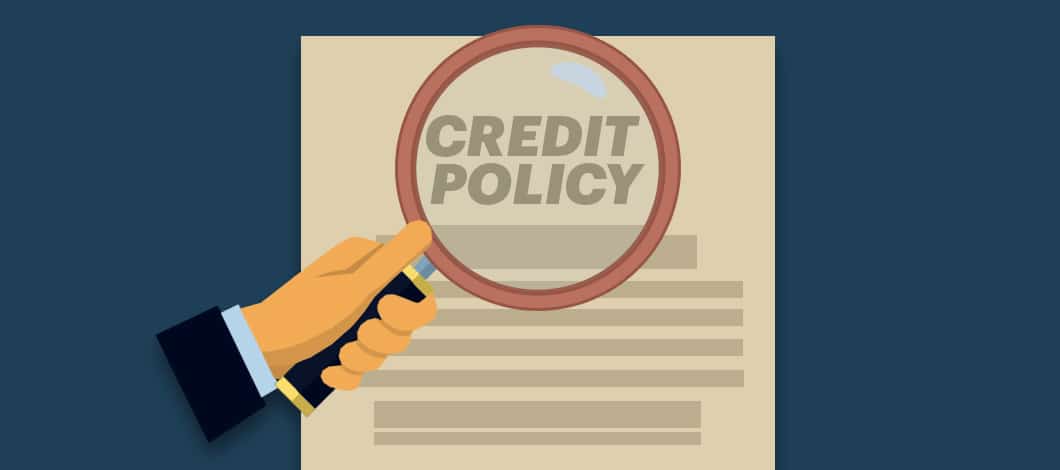Knowing how to write a credit policy can help you promote customer purchases and avoid common problems.
Here’s how to create one. We’ll cover what a business credit policy is, what it consists of and how to write one. Moreover, we’ve included a credit management policy template to help you design your own customized policy statement.
What Is a Business Credit Policy?
A business credit policy is a written statement documenting your company’s guidelines and procedures for approving credit to customers and collecting delinquent payments. Why do this? Because having written credit policy guidelines helps you evaluate credit risks and manage debt collection.
A credit policy can protect you from approving customers who aren’t likely to pay you back on time. It also gives you a game plan for recovering debt from delinquent accounts. These benefits allow you to enjoy the advantages of extending consumer financing to customers while reducing the risk of cash-flow problems caused by customers who don’t pay what they owe.
A credit policy may be a short statement of your business credit terms and conditions. However, it may be expanded into a detailed credit procedure manual. It all depends on the needs of your company. For example, a company in the financial services industry that offers a wide range of business loan products may have a much more detailed credit policy than a furniture retailer that offers a single retail credit card only good for that store.

What Are the Elements of a Credit Policy?
A good credit policy should include a number of essential elements, such as:
- Policy purpose
- Policy scope
- Credit limits
- Credit terms
- Approval process
- Applicant documentation requirements
- Credit approval criteria
- Credit approval authority
- Collection policy
Keep in mind, however, the length of these sections may vary with your needs.
Here’s a brief rundown of what each section may cover:
Policy Purpose
This section summarizes why you’re writing your policy. For example, the purpose of your policy might be to document your policies for approving credit and collecting delinquent payments.
Policy Scope
This specifies what types of sales your policy applies to. For instance, your policy might be limited to certain types of products or stores in a specific geographical region.
Credit Limits
Here you define your maximum credit limits for customers meeting your approval criteria. You also may wish to define different limits for customers who meet different criteria.
For example, customers might have different credit limits depending on what their credit score is, their revenue level or how long they’ve been customers. You might specify that credit managers have the authority to raise limits under specific circumstances.
Credit Terms
This section lays out what type of repayment terms you extend your customers. For example, you might allow customers 30 days after their invoice date before payment becomes due, known as net 30.
In addition, his section may include other terms, such as advance payment discounts.
Credit Approval Process
Here you summarize the steps in your credit approval process. For example, your policy may be to review the credit applications of all new customers and to review the credit of existing customers once a year or as circumstances warrant.
Applicant Documentation Requirements
In this section, indicate which documents applicants must provide to be considered for credit. For example, you may require financial statements, bank statements and tax returns.
You also may indicate that different documents are required under specific circumstances. For instance, applicants may be required to provide additional documentation for credit limits exceeding a designated amount.
Credit Approval Criteria
This section documents which criteria you use to approve credit. For example, for business clients, you may require a certain revenue level, number of years in business and credit score.
You might note circumstances where credit is approved but qualified. For instance, customers in a certain credit score range may qualify for a lower amount of credit.
Credit Approval Authority
So, here you identify who has the authority to make credit approval decisions. You might indicate that credit managers are authorized to make decisions on limits up to a certain amount but applications for amounts exceeding this limit require approval from a more senior position such as the vice president of credit or the finance director.
You may delegate related responsibilities to different parties. For example, you might specify which positions or departments are responsible for communicating credit decisions to customers, tracking accounts receivable and handling collections.
Collection Policy
In this section, you outline your policies for handling delinquent payments. For instance, you might state:
- What steps your business will take to collect from accounts that go past due
- How many days an account may go past due before it gets referred to a debt collection agency
How to Write a Credit Policy
The Credit Research Foundation, a nonprofit group serving the credit and accounts receivable industries, recommends structuring your credit policy document around 6 categories of critical questions, as summarized by credit services provider Dun & Bradstreet:
- What is your credit policy’s mission?
- To be clear, what are your goals?
- What are your terms of sale?
- How is credit evaluated?
- Who has specific credit responsibilities?
- How are collections handled?
To help you flesh out your answers to these questions, here’s a more detailed list of questions covering these categories:
- What is the purpose of your credit policy?
- The scope of your credit policy: What is it?
- What is your maximum credit limit?
- Under what circumstances are credit limits lowered?
- Can limits be raised with a manager’s approval?
- How long are repayment terms?
- What process is used to review credit applications?
- What information must credit applicants provide?
- The documentation: What must credit applicants include?
- What criteria are used to approve credit?
- When are guarantees required?
- What process is used to review credit periodically?
- Who is responsible for approving credit applications?
- Who is responsible for advising customers of credit decisions and details?
- What are the steps in your collection policy?
Use this question checklist as a starting point to help you develop your credit policy. Depending on your needs, you may wish to include additional questions going into more detail in certain areas.

Here’s a Credit Policy Example Template
To help you organize your answers to the above types of questions into a formal document, it can be helpful to follow a credit policy template.
Here’s a sample structure you can use to create your own credit policy:
Purpose
This statement outlines Acme Co.’s policies and procedures for approving customer credit and collecting delinquent payments.
Scope
This policy applies to all credit sales made within the U.S. and its territories.
Credit Limits and Terms
Acme Co. will extend credit to all customers who meet qualifying criteria. The standard credit limit for new qualifying customers is $5,000. Raise the limit at the discretion of the credit manager.
Accounts that remain in good standing for 12 months may have their credit limit raised to $10,000.
All terms are net 30. Terms may be extended to net 60 upon approval from credit managers.
Credit Evaluation Procedures
The credit department will review all credit applications from new customers to determine eligibility.
Extend credit to customers whose companies have monthly revenue of $10,000 or more, with at least 6 months in business and business credit scores of 80 or more. For companies that have been in business less than 12 months, the owner must have a personal credit score of at least 670 and the applicant must provide a personal guarantee, corporate guarantee or bank guarantee.
Review customer credit status on an annual basis 12 months after their initial approval and every 12 months thereafter. Additionally, review credit status at the credit manager’s discretion in response to business or economic conditions. Consider customer repayment history, credit usage and changes in income level.
Credit Policy Responsibility
Credit managers are authorized to approve credit and to communicate approval and review decisions to customers. The accounts receivable department will track customer payments and provide monthly reports to the credit department. As for delinquent cases, they get referred to the collections department.
Collections Procedures
For customers who are late on payments, send a reminder 7 days after their invoice becomes due. Advise them a late fee of 1% will be due after 14 days. Send a second notice if payment hasn’t been received after 14 days. State that the invoice is due immediately, along with the late fee. Also, note that if payment isn’t received, the account will be referred for collection action.
Follow-up notices will be sent after 30 and 60 days. After 90 days, the account will be referred to a collection agency.
Craft a Credit Policy to Encourage Customer Spending
A written business credit policy documents your company’s guidelines and procedures for approving credit and collecting delinquent payments. This allows you to enjoy the benefits of allowing customers to buy on credit without exposing your company to excessive risk.
A well-designed credit policy statement should cover your policy’s purpose, scope, credit limits, credit terms, approval procedures and collections procedures. The best way to develop a policy statement is to go through a checklist of questions covering these areas. Next, use a template such as the one provided above to organize your answers into a written credit policy statement.
Create a credit policy statement so you can increase your revenue by encouraging customers to buy with credit.










